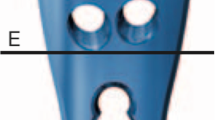Abstract
Objective
The development of locking plate systems has led to polyaxial screws and new plate designs. This study compares monoaxial head locking screws (PHILOS© by Synthes) and a new generation of polyaxial locking screws (NCB-LE© by Zimmer) with respect to biomechanical stability.
Methods
On nine pairs of randomised formalin fixed humerus specimens, standardised osteotomies and osteosyntheses with nine monoaxial (group A) und nine polyaxial (group B) plate/screw systems were performed. A material testing machine by Instron (M-10 14961-DE) was used for cyclic stress tests and crash tests until defined breakup criteria as endpoints were reached.
Results
After axial cyclic stress 200 times at 90 N, plastic deformation was 1.02 mm in group A and 1.25 mm in group B. After the next cycle using 180 N the additional deformation averaged 0.23 mm in group A and 0.39 mm in group B. The deformation using 450 N was 0.72 mm in group A compared to 0.92 mm in group B. The final full power test resulted in a deformation average of 0.49 mm in group A and 0.63 mm in group B after 2,000 cycles using 450 N. When reaching the breakup criteria the plastic deformation of the NCB plate was 9.04 mm on average. The PHILOS plate was similarly deformed by 9.00 mm.
As a result of the crash test, in group A the screws pulled out of the humeral head four times whereas the shaft broke one time and another time the implant was ripped out. The gap was closed four times. In group B, there were three cases of screw cut-through, four shaft fractures/screw avulsions from the shaft and two cases of gap closure.
Conclusion
The two systems resist the cyclic duration tests and the increasing force tests in a similar manner. The considerable clinical benefits of the polyaxial system are enhanced by equal biomechanical performance.






Similar content being viewed by others
References
Blum J, Hansen M, Rommens P (2009) Die winkelstabile Marknagelung bei Frakturen am proximalen Humerus mit dem PHN (Proximaler Humerusnagel). Oper Orthop Traumatol 21:296–311
Erhardt J, Roderer G, Grob K, Forster T, Stoffel K, Kuster M (2009) Early results in the treatment of proximal humeral fractures with a polyaxial locking plate. Arch Orthop Trauma Surg 129:1367–1374
Hessler C, Schmucker U, Matthes G, Ekkernkamp A, Gütschow R, Eggers C (2006) Ergebnisse nach Versorgung instabiler proximalerHumerusfrakturen mittels winkelstabiler Platte. Unfallchirurg 109:867–874
Hessmann M, Rommens P (2001) Osteosynthesetechniken bei proximalen Humerusfrakturen. Chirurg 72:1235–1245
Hessmann M, Sternstein W, Mehler D, Korner J, Hofmann A, Rommens P (2004) Sind winkelstabile Plattensysteme mit elastischen Eigenschaften fürdie Stabilisierung der Oberarmkopffraktur vorteilhaft? Biomed Technik 49:345–350
Hessmann M, Sternstein W, Krummenauer F, Hofmann A, Rommens P (2004) Osteosynthese von Oberarmkopffrakturen—Einfluss desImplantatdesigns auf die biomechanische Stabilität. Chirurg 75:167–174
Kettler M, Braunstein V, Biberthaler P, Krammer M, Mutschler W (2007) Komplikationen winkelstabiler Plattenosteosynthesen am Humeruskopf—Darstellung und Management. Trauma Berufskrankh 9:48–53
Lever J, Aksenov S, Zdero R, Ahn H, McKee M, Schemtisch E (2008) Biomechanical analysis of plate osteosynthesis systems for proxima humerus fractures. J Orthop Trauma 22:23–29
Lill H, Josten C (2001) Konservative oder operative Versorgung derHumeruskopffraktur beim alten Menschen? Chirurg 72:1224–1234
Lohmann R, Haid K, Stöckle U, Raschke M (2007) Epidemiologie und Perspektiven der Alterstraumatologie. Unfallchirurg 110:553–562
Maurer J, Rüter A (2004) Winkelstabile Plattenosteosynthese amproximalen Humerus—Ein klinischer Vergleich von etablierten und neuenVerfahren. Trauma Berufskrankh 6:247–250
Röderer G, Gebhartd F, Erhardt J, Al-Agha S, AbouElsoud M, Kinzl L (2007) Die non-contact-bridging(NCB)-Platte. Unfallchirurg 110:505–512
Röderer G, AbouElsoud M, Gebhard F, Claes L, Aschoff A, Kinzl L (2010) Biomechanische Untersuchungen der winkelstabilen Plattenosteosyntheseam proximalen Humerus. Unfallchirurg 113:133–138
Strohm P, Köstler W, Südkamp N (2008) Proximale Humerusfrakturen—was sollen wir tun? Z Orthop Unfall 146:312–317
Südkamp N (2004) Erste Erfahrungen mit winkelstabilen Implantaten –obere Extremität: subcapitale Humerusfrakturen. Trauma Berufskrankh 6:13–18
Südkamp N, Bayer J, Hepp P, Voigt C, Oestern H, Kääb M, Luo C, Plecko M, Wendt K, Köstler W, Konrad G (2009) Open reduction and internal fixation of proximal humeral fractures with use of the locking proximal humerus plate. Results of a prospective, multicenter, observational study. J Bone Joint Surg Am 91:1320–1328
Virkus W, Goldberg S, Lorenz E (2008) A comparison of compressive force generation by plating and intramedullary nailing techniques in a transverse diaphysial humerus fracture model. J Trauma 65:103–108
Voigt C, Woltmann A, Lill H (2007) Komplikationsmanagement nach winkelstabiler Plattenosteosynthese am proximalen Humerus. Chirurg 78:40–46
Voigt C, Lill H (2007) Versorgung proximaler Humerusfrakturen—Fortschritte in der Plattenosteosynthese. Trauma Berufskrankh 9:43–47
Wilkens K, Curtiss S, Lee M (2008) Polyaxial locking plate fixation in distal femur fractures: a biomechanical comparison. J Orthop Trauma 22:624–628
Wingerter S, Calvert G, Tucci M, Benghuzzi H, Russel G, Puckett A (2006) Mechanical strength repercussions of various fixative storage methods on bone. Biomed Sci Instrum 42:290–295
Zech S, Goesling T, Hankemeier S, Knobloch K, Geerling J, Schultz-Brunn K, Krettek C, Richter M (2006) Differences in the mechanical properties of calcaneal artificial specimens, fresh frozen specimens and embalmed specimens differ in experimental testing. Foot Ankle Int 27(12):1126–1136
Conflict of interest
The authors declare that they have no conflict of interest.
Author information
Authors and Affiliations
Corresponding author
Rights and permissions
About this article
Cite this article
Zettl, R., Müller, T., Topp, T. et al. Monoaxial versus polyaxial locking systems: a biomechanical analysis of different locking systems for the fixation of proximal humeral fractures. International Orthopaedics (SICOT) 35, 1245–1250 (2011). https://doi.org/10.1007/s00264-011-1220-z
Received:
Accepted:
Published:
Issue Date:
DOI: https://doi.org/10.1007/s00264-011-1220-z




